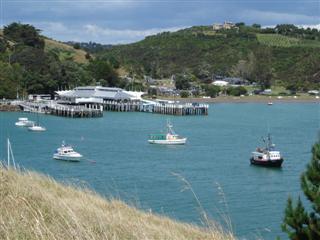Please show your support of Waihekepedia by adding a link to us from your web site. Waihekepedia T Shirts now available at the Ostend Market
Matiatia
Matiatia
About Matiatia
Matiatia Bay is located at the western end of Waiheke Island and features the Matiatia Ferry Terminal which is the arrival point for the passenger ferries from downtown Auckland.
History
Several wahi tapu along the foreshore, each with human remains confirmed by ground-penetrating radar, attest to the use of Matiatia by Maori in pre-European days. Later the land at Matiatia was owned by the Alison family.
== The controversy
Auckland City acknowledges on its own web page for Matiatia that the gateway bay "should be home to a world-class sustainable development".
Current Land Development Plans from Auckland City Council
Matiatia, Waiheke Island, New Zealand is an important strategic asset that needs to be developed in a way that is inspirational and extraordinary.
The landscape of the 4.25 hectare Matiatia Valley serves as the gateway to Waiheke Island and should be home to a world-class sustainable development.
In a bid to see such a development on site, Auckland City launched an international search for ideas to develop Matiatia. Cash prizes were offered for finalists and the designer of the final concept chosen by the council will have the opportunity to help develop their design on the site.
To guide designers, the council engaged a working party to develop a design brief for the site. The working party was made up of
- architects
- designers
- property developers
- councillors and
- community representatives.
The brief, 'A vision for Matiatia', incorporated both the design principles established by the Waiheke community and the elements Auckland City wants to see included in any development.
'A Vision for Matiatia' was a two stage process.
The first stage was open to any interested party and 75 designs were submitted. These entries went on public display and about 400 visitors completed a feedback form. An assessment panel (made up of built environment professionals and community representatives) selected five finalists from these 75 and further refined the design brief taking into account the public feedback. These finalists then submitted more detailed designs for stage two, which were also displayed for public feedback. The assessment panel then met again to select a preferred concept .
Design 201 was recommended by the assessors to the committee as the preferred concept.
This concept will be further developed by a working party, in association with the preferred design team and passed to the council's Property Enteprise Board for implementation.
